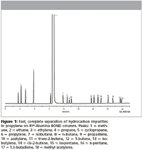17 Min D2712 Analysis of Impurities in Propylene Using PLOT Columns
Capillary PLOT columns can be a simpler alternative to packed column setups for propylene analysis. Here we demonstrate a single column setup that provides fast baseline resolution of propylene impurities.
Rick Morehead and Jan Pijpelink, Restek Corporation
Propylene production exceeds that of most other hydrocarbons worldwide, as it is a key component in many hard plastics, primarily polypropylene, that are used in a broad range of industries. Propylene is generated by several methods which utilize various catalysts to increase production efficiency. Regardless of the production method, high purity product is extremely important to prevent damage to the catalysts. Purity often is determined using ASTM Method D2712, which can be performed on any gas chromatographic system capable of detecting compounds at concentrations of at least 20 ppm. While a wide variety of column choices are permissible, complex setups using multiple packed columns are often used and suffer from poorly resolved peaks or long run times.
Capillary PLOT columns can be a more effective option than packed columns for propylene analysis. Alumina PLOT columns, in particular, offer a high degree of selectivity for resolving low molecular weight hydrocarbons. Deactivation type can also enhance the separation between challenging compounds. Here, an Rt®-Alumina BOND column with a Na2SO4 deactivation was used to illustrate a simple single column setup that results in fast, baseline resolution of low molecular weight hydrocarbons from propylene.

Results
While separation of the compounds typically encountered in a propylene stream is often difficult to achieve using packed columns, all compounds were fully resolved on an Rt®-Alumina BOND/Na2SO4 PLOT column. High column efficiency provided excellent separation, even for difficult to resolve compounds like cyclopropane and propylene. The Rt®-Alumina BOND/Na2SO4 PLOT column also exhibited high capacity (loadability), as evidenced by the minimal amount of tailing on the propylene peak. Improved peak shape for high concentration compounds simplifies identification and quantification of other compounds that elute near the tailing edge of the major peak.
In addition to providing complete separation of all compounds on a single column, the use of an Rt®-Alumina BOND/Na2SO4 PLOT column resulted in a fast analysis time. In comparison to packed column methods, which can require multiple columns and up to 45 min per run, the total run time using the Rt®-Alumina BOND/Na2SO4 PLOT column was only 17 min. High sample throughput is further supported by the short temperature program used here, as compared to some of the isothermal conditions and longer run times noted in the method.

Figure 1
Conclusions
The analysis of impurities in propylene can be significantly improved by using a single Rt®-Alumina BOND/Na2SO4 PLOT column instead of a multiple-column packed column setup. When testing for hydrocarbon impurities in propylene using ASTM D2712-91, the use of an Rt®-Alumina BOND/Na2SO4 column provided fast analysis times and complete separation of all target compounds.

Restek Corporation
110 Benner Circle, Bellefonte, PA 16823
tel. (800)356-1688; fax: (814)353-1309
Website: www.restek.com

SEC-MALS of Antibody Therapeutics—A Robust Method for In-Depth Sample Characterization
June 1st 2022Monoclonal antibodies (mAbs) are effective therapeutics for cancers, auto-immune diseases, viral infections, and other diseases. Recent developments in antibody therapeutics aim to add more specific binding regions (bi- and multi-specificity) to increase their effectiveness and/or to downsize the molecule to the specific binding regions (for example, scFv or Fab fragment) to achieve better penetration of the tissue. As the molecule gets more complex, the possible high and low molecular weight (H/LMW) impurities become more complex, too. In order to accurately analyze the various species, more advanced detection than ultraviolet (UV) is required to characterize a mAb sample.